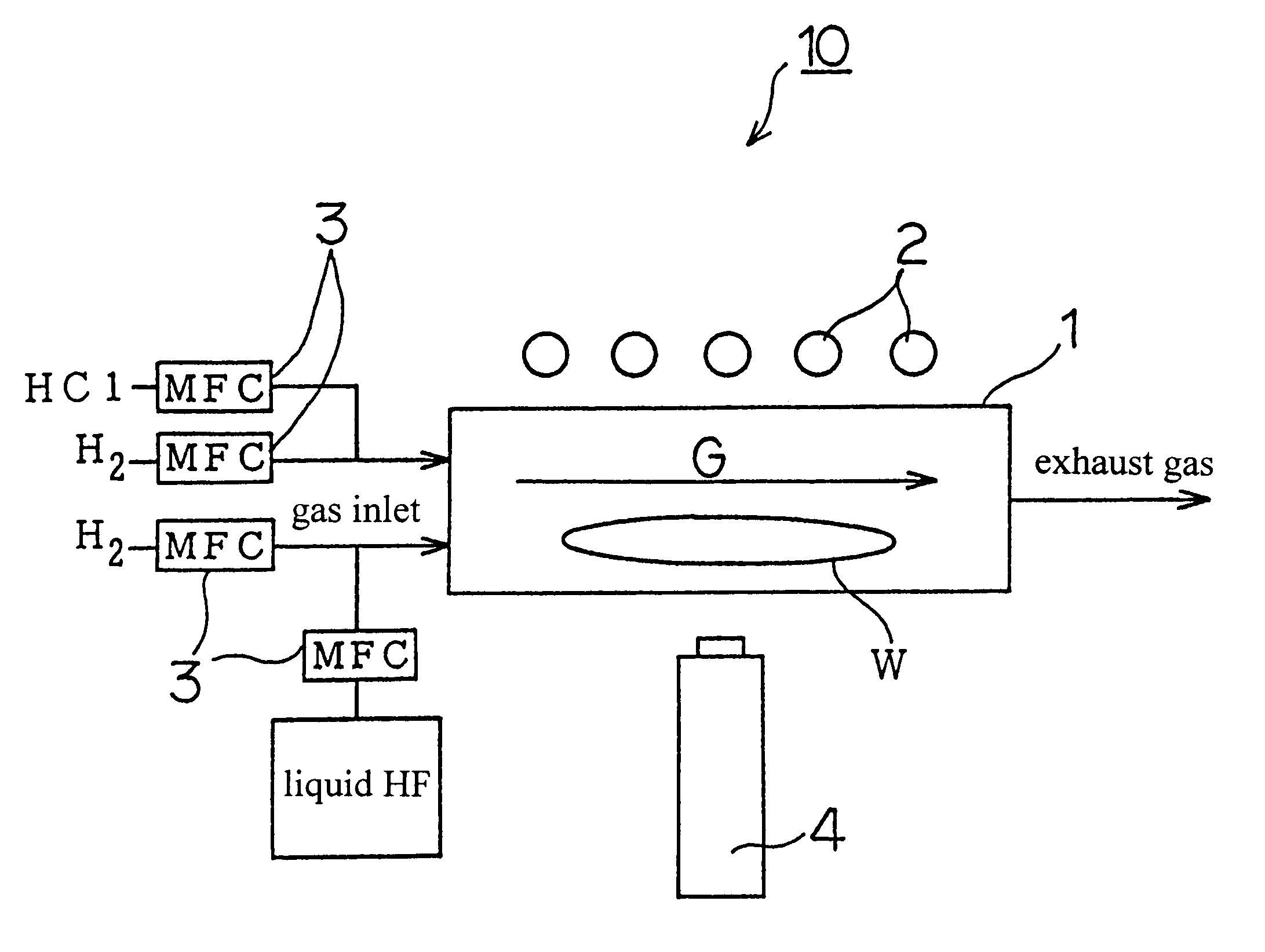Process for cleaning silicon semiconductor substrates
a technology for silicon semiconductor substrates and cleaning processes, applied in chemical instruments and processes, detergent compositions, electrical equipment, etc., can solve the problems of unintentional attachment of impurities and growth of oxide films, surface roughening of substrates, and inability to avoid reattachment of impurities to silicon-based semiconductor substrates during cleaning, so as to achieve high vapor pressure and prevent regrowth
- Summary
- Abstract
- Description
- Claims
- Application Information
AI Technical Summary
Problems solved by technology
Method used
Image
Examples
example 1
In the example, organic materials attaching to a natural oxide film are removed using the vapor phase treatment apparatus 10 shown in FIG. 1 and a process in which a natural oxide film is retained will be described.
Wafers W used as samples were made from silicon single crystal with a diameter of 200 mm and a natural oxide film was formed thereon by leaving in a clean air for a full day. A thickness of the attaching film which attached to a surface of each wafer W was totally 1.3 nm, which film included a natural film 1.1 nm thick and an organic material film 0.2 nm thick. The thicknesses had been confirmed in advance by means of ellipsometry and X-ray photoelectron spectroscopy (XPS). Each wafer W was placed in the treatment chamber 1 in which the atmosphere was replaced with H.sub.2 in advance, and temperature and a pressure were respectively maintained at 23.degree. C. and 1 atm and the wafers W were heated to respective temperatures of 100.degree. C., 300.degree. C., 400.degree. ...
example 2
In the example, description will be made of a process in which a natural oxide film is removed by supplying HF gas while keeping temperatures of wafers W at room temperature, followed by a process in which organic materials are removed.
Wafers W that were used as samples were same as those used in Example 1. Each wafer W was placed in the treatment chamber 1 in which the atmosphere was replaced with H.sub.2 in advance and temperature and a pressure were respectively maintained at 23.degree. C. and 1 atm and 1% HF gas diluted with H.sub.2 gas was made to flow from one end of the treatment chamber 1 at a flow rate of 100 l / min for 1 min to remove a natural oxide film.
A fact that a natural oxide film of each wafer W was removed was confirmed by means of ellipsometry.
The reason why a natural oxide film was removed in the example is that a temperature of each wafer W was kept at room temperature during supply of HF gas and thereby, release of water that was adsorbed on or occluded in the ...
example 3
In the example, description will be made of a process in which an organic film attaching to a thermal oxide film is removed. Wafers W used as samples were silicon single crystal substrates, placed in a high temperature oxygen atmosphere so as to form a thermal oxide film 200 nm thick on a surface of each of the wafers W and the wafers W each with the thermal oxide film thereon were further left in a clean air for a full day to form an organic material film 0.2 nm thick on the thermal oxide film. Similar to Example 1, the wafers W were in the following order subjected to steps of: raising temperature to in the range of from 100.degree. C. to 600.degree. C.; decomposition of organic materials by HF gas; holding in a H.sub.2 atmosphere; raising temperature; and vaporization of a decomposition product in the H.sub.2 atmosphere, whereby the organic material film was removed. A fact that the organic material film had been removed was confirmed by observation in which no photoelectron orig...
PUM
| Property | Measurement | Unit |
|---|---|---|
| temperature | aaaaa | aaaaa |
| temperature | aaaaa | aaaaa |
| temperature | aaaaa | aaaaa |
Abstract
Description
Claims
Application Information
 Login to View More
Login to View More - R&D
- Intellectual Property
- Life Sciences
- Materials
- Tech Scout
- Unparalleled Data Quality
- Higher Quality Content
- 60% Fewer Hallucinations
Browse by: Latest US Patents, China's latest patents, Technical Efficacy Thesaurus, Application Domain, Technology Topic, Popular Technical Reports.
© 2025 PatSnap. All rights reserved.Legal|Privacy policy|Modern Slavery Act Transparency Statement|Sitemap|About US| Contact US: help@patsnap.com


